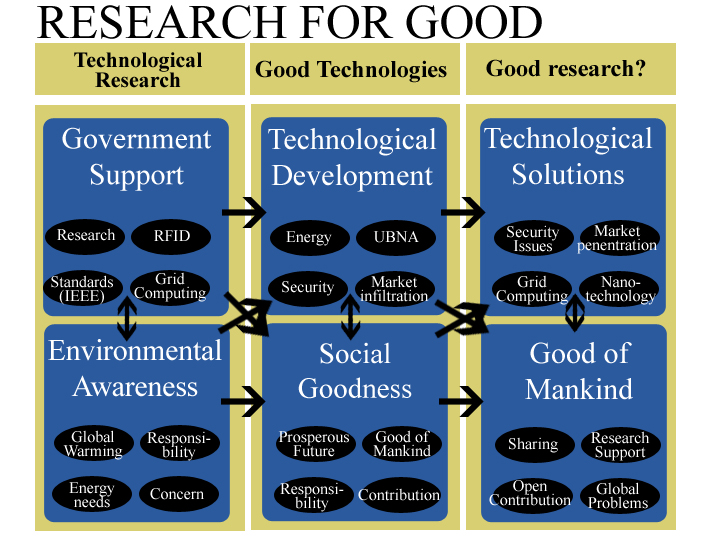RESEARCH FOR GOOD
Breadcrumbs: The Future of Ubiquitous computing in 2025 --> RESEARCH FOR GOOD
2007-2013 – Technological Research
At the 2007 CeBIT trade show EU Commissioner Viviane Reding announces about new plans of wide range governmental support from the EU to RFID technology development – while at the same time holding off implementations of regulations on to the fast growing technology.(1) This announcement paves the way for a more prosperous future for ubiquitous computing, increasing spending and investments in research and development of related fields. Parallel to EU’s initiative also the Institute of Electrical and Electronics Engineers (IEEE) increases support to international standardisation and development of ubiquitous engineering. 2007 marks the start of several IEEE supported annual conferences in search for answers and standards covering ubiquitous computing in relation to multimedia(2), grid computing(3) and related security(4) measures. Increased worldwide support and strengthening media coverage sparks the interest of new students and entrepreneurs to focus more directly in the fields of everyware.
By the turn of the decade RFID is becoming the de facto standard among all logistics and transportation companies, as well as large scale wholesalers and importers. Its popularity is catching also on to airports and airliners, which start experimenting implementing it as part of the barcodes in luggage handling to still meet the needs at both modern and traditional airports. Increased support into RFID starts also to payback as more efficient and cost effective methods are created to mass produce and program RFID tags, enabling manufacturers and resellers to start planning investments into new production, logistics and sale chains. In the mean time obvious signals of global warming increase general environmental awareness and responsibility among all humans, while trying to find energy efficient solutions and alternative energy sources to the already existing energy needs(5) – the green movement is getting more and more concerned over the energy needs of ubiquitous computing.
2013-2019 – Good Technologies
Increasing energy consumption isn’t the only obstacle to be overcome to make ubiquitous computing really take off. With ever expanding universal broadband network access, more and more devices are being linked to one another and basically open to the whole world. Finding sound security protocols and methods to protect against different forms of cyber terrorism is suddenly becoming the biggest priority for organisations involved with pervasive devices. Thanks to early investment in related research and technology development, scientist and engineers are able to come up with more energy efficient solutions for ubiquitous computing. By switching to energy efficient algorithms(6) and processors (FPGA’s)(7) manufacturers are able to cut energy demands of ubiquitous and ICT related products close to tenfold. By the middle of the decade ubiquitous home appliances are becoming more and more popular among the upper class households.
With increasing concern of the well being of mother earth, more and more people jump on the bandwagon to build up a prosperous future also for our children. There are several signs of the good of mankind taking a foothold among individuals. More and more money is invested in charity funds and research grants, people are finally willing to take on more responsibility of the well being of the whole planet and look to contribute anyway possible. By the end of the decade RFID tags are spreading to all mass produced consumer goods, bringing full-potential for ubiquitous home appliances. With additional help and support from home appliance manufacturers, eager to start mass production of ubiquitous white goods.
2019-2025 – Good research?
Just like with the energy efficient algorithms and processors, increased investment in research also pays-off with the related security issues. ICT security specialist are able to develop simple yet secure private VPN algorithms allowing secure communication among interlinked devices as well as enhance the artificial intelligence of ICT devices to enable self protecting and self healing functionalities, ensuring the final breakthrough of ubiquitous home appliances to mass markets. With lower energy consumption levels as traditional white good, governments are even willing to allow tax deductions for the purchases of new appliances.
With increased penetration of ubiquitous computing, development of efficient and subtle grid computing algorithms, safe and secure universal broadband network connection and existing openness to contribute to the good of mankind, researches and engineering start promoting ways for everyone to contribute to the research and development of solutions to global problems. By downloading available applications and installing them to ubiquitous devices at home and at work, individuals can allow university and research networks and simulations to utilize their processing power while home appliances are idle. Similar to the once popular SETI@home and folding@home(8) projects, individuals and companies can now take part in finding cures to diseases, solutions to fight against global warming, support cost effective growth in third world countries as well as prediction and prevention of natural disasters.
Within the next couple of years already 20% of the ubiquitous home appliance customer base is contributing to the good of mankind. By the middle of the decade researchers have been able to construct in laboratory conditions nanotechnology level RFID mock-ups with the help of carbon-nano-tubes. Opening up possibilities in the future to integrate RFID technology even inside the food and beverages we consume. Allowing doctors and health specialist in the future easy access to summarize what we’ve consumed and how we nourish ourselves. When does human goodness become too much?
References:
(1) http://www.eweek.com/article2/0,1895,2104417,00.asp
(2) http://www.sersc.org/MUE2007/
(3) http://www-lipn.univ-paris13.fr/GPC2007/
(4) http://www.sersc.org/MUE2007/contents/page/GPCS07.html
(5) http://www.ase.org/
(6) http://www-lipn.univ-paris13.fr/GPC2007/programGPC2007.html
(7) http://www.iee.org/OnComms/magazine.cfm?issueID=167&articleID=3B3667E7-E83A-B701-3AD77414055BB366
(8) http://folding.stanford.edu/
